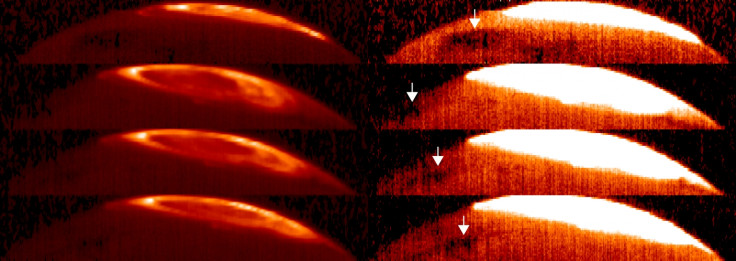Great Cold Spot anomaly discovered on Jupiter is created by the aurora
The Great Cold Spot is as big as the Great Red Spot but has eluded astronomers for decades.
A cold, dark feature in Jupiter's atmosphere found near its aurora has been discovered. It measures 24,000 km by 12,000 km, around the same size as the planet's famous Great Red Spot.
It is the second ''great spot'' discovered on the planet. Unlike the Great Red Spot, this new spot is found high up in the planet's thermosphere. The Great Cold Spot is about 200C cooler than the atmosphere around it. However, by Earth's standards, this is still scorchingly hot, at between 426 and 726C.
The feature is thought to be created by Jupiter's powerful polar aurorae. As the gas giant's magnetic field interacts with the planet's atmosphere, it drives currents of heat around the planet. But in the outermost layer of the atmosphere, this creates a vortex of cooler gases area.
"This is the first time any weather feature in Jupiter's upper atmosphere has been observed away from the planet's bright aurorae," said study author Tom Stallard of the University of Leicester in the UK.
The spot was detected using the CRIRES (Cryogenic High-resolution Infrared Ehelle Spectrograph) instrument of the Very Large Telescope. The researchers measured H3+ ions in Jupiter's atmosphere, the concentration of which is related to temperature. They combined this data with image from Nasa's InfraRed Telescope Facility.
This gave them a total of 13,000 images dating back from 1995 to comb through to see how long the spot has been there, and map how it has changed historically.
"The Great Cold Spot is much more volatile than the slowly changing Great Red Spot, changing dramatically in shape and size over only a few days and weeks, but it has re-appeared for as long as we have data to search for it, for over 15 years.

"That suggests that it continually reforms itself, and as a result it might be as old as the aurorae that form it – perhaps many thousands of years old."
The discovery of the Great Cold Spot suggests that there may be other large anomalies in Jupiter's atmosphere that have been missed by scientists so far.
"The detection of the Great Cold Spot was a real surprise to us, but there are indications that other features might also exist in Jupiter's upper atmosphere. Our next step will be to look for other features in the upper atmosphere, as well as investigating the Great Cold Spot itself in more detail," said Stallard.

© Copyright IBTimes 2025. All rights reserved.






















